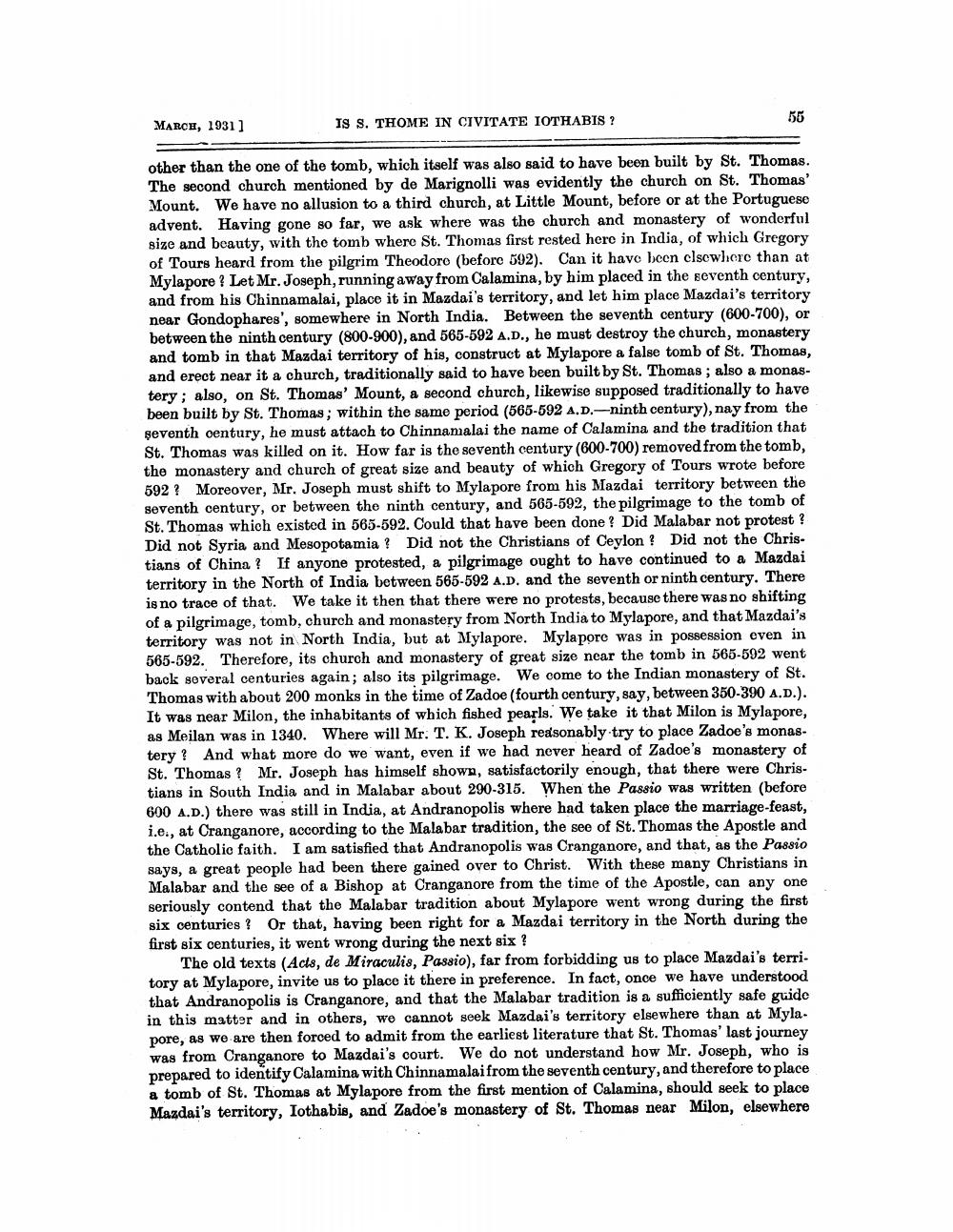________________
MARCH, 1931)
IS S. THOME IN CIVITATE IOTHABIS ?
other than the one of the tomb, which itself was also said to have been built by St. Thomas. The second church mentioned by de Marignolli was evidently the church on St. Thomas' Mount. We have no allusion to a third church, at Little Mount, before or at the Portuguese advent. Having gone so far, we ask where was the church and monastery of wonderful size and beauty, with the tomb where St. Thomas first rested here in India, of which Gregory of Tours heard from the pilgrim Theodoro (before 592). Can it have been elsewhere than at Mylapore ? Let Mr. Joseph, running away from Calamina, by him placed in the seventh century, and from his Chinnamalai, place it in Mazdai's territory, and let him place Mazdai's territory near Gondophares', somewhere in North India. Between the seventh century (600-700), or between the ninth century (800-900), and 565-592 A.D., he must destroy the church, monastery and tomb in that Mazdai territory of his, construct at Mylapore a false tomb of St. Thomas, and erect near it a church, traditionally said to have been built by St. Thomas; also a monastery; also, on St. Thomas' Mount, a second church, likewise supposed traditionally to have been built by St. Thomas, within the same period (565-592 A.D.-ninth century), nay from the seventh century, he must attach to Chinnamalai the name of Calamina and the tradition that St. Thomas was killed on it. How far is the seventh century (600-700) removed from the tomb, the monastery and church of great size and beauty of which Gregory of Tours wrote before 592 ? Moreover, Mr. Joseph must shift to Mylapore from his Mazdai territory between the seventh century, or between the ninth century, and 565-592, the pilgrimage to the tomb of St. Thomas which existed in 565-592. Could that have been done? Did Malabar not protest? Did not Syria and Mesopotamia ? Did not the Christians of Ceylon? Did not the Christians of China ? If anyone protested, a pilgrimage ought to have continued to a Mazdai territory in the North of India between 565-592 A.D. and the seventh or ninth century. There is no trace of that. We take it then that there were no protests, because there was no shifting of a pilgrimage, tomb, church and monastery from North India to Mylapore, and that Mazdai's territory was not in North India, but at Mylapore. Mylapore was in possession even in 565-592. Therefore, its church and monastery of great size near the tomb in 565-592 went back several centuries again; also its pilgrimage. We come to the Indian monastery of St. Thomas with about 200 monks in the time of Zadoe (fourth century, say, between 350-390 A.D.). It was near Milon, the inhabitants of which fished pearls. We take it that Milon is Mylapore, as Meilan was in 1340. Where will Mr. T. K. Joseph reasonably try to place Zadoe's monastery? And what more do we want, even if we had never heard of Zadoe's monastery of St. Thomas? Mr. Joseph has himself shown, satisfactorily enough, that there were Christians in South India and in Malabar about 290-315. When the Passio was written (before 600 A.D.) there was still in India, at Andranopolis where had taken place the marriage-feast, i.e., at Cranganore, according to the Malabar tradition, the see of St. Thomas the Apostle and the Catholic faith. I am satisfied that Andranopolis was Cranganore, and that, as the Passio says, a great people had been there gained over to Christ. With these many Christians in Malabar and the see of a Bishop at Cranganore from the time of the Apostle, can any one seriously contend that the Malabar tradition about Mylapore went wrong during the first six centuries? Or that, having been right for a Mazdai territory in the North during the first six centuries, it went wrong during the next six ?
The old texts (Acts, de Miraculis, Passio), far from forbidding us to place Mazdai's territory at Mylapore, invite us to place it there in preference. In fact, once we have understood that Andranopolis is Cranganore, and that the Malabar tradition is a sufficiently safe guido in this matter and in others, we cannot seek Mazdai's territory elsewhere than at Myla. pore, as we are then forced to admit from the earliest literature that St. Thomas' last journey was from Cranganore to Mazdai's court. We do not understand how Mr. Joseph, who is prepared to identify Calamina with Chinnamalai from the seventh century, and therefore to place a tomb of St. Thomas at Mylapore from the first mention of Calamina, should seek to place Mazdai's territory, Iothabis, and Zadoe's monastery of St. Thomas near Milon, elsewhere




